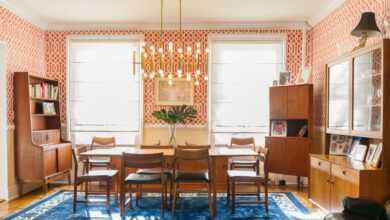How to Create a Zen Space at Home for Relaxation and Stress Relief
In this comprehensive guide, we’ll walk you through the steps to create a Zen space at home , while exploring essential design elements.

In today’s fast-paced and stress-filled world, the importance of having a peaceful sanctuary within your home cannot be overstated. More than ever, people are turning to holistic approaches for mental wellness and self-care. One of the most effective ways to promote tranquility is to create a Zen space at home—a serene corner where you can unwind, meditate, and recharge your mind and body.
In this comprehensive guide, we’ll walk you through the steps to design a calming Zen-inspired environment, while exploring essential design elements, wellness tips, and stress-relief strategies that you can incorporate into your daily life.
What Is a Zen Space?
A Zen space is a thoughtfully curated area that encourages mindfulness, relaxation, and introspection. Rooted in Zen Buddhism, this concept emphasizes simplicity, harmony, and balance. Unlike traditional home décor, Zen design focuses on minimalism and the natural flow of energy (Chi), making it ideal for stress relief and mental clarity.
Create a Zen space at home doesn’t mean overhauling your entire house. It’s about designing a dedicated corner or room that radiates calmness—whether it’s a cozy meditation nook, a calming reading area, or a spa-like bathroom retreat.
Benefits of Create a Zen Space at Home
When you create a Zen space at home, you’re not just upgrading your interior design—you’re investing in your overall well-being. Here are some compelling reasons to get started:
- Reduces stress and anxiety
- Promotes mental clarity and focus
- Improves sleep quality
- Encourages mindfulness and meditation
- Boosts emotional and physical wellness
- Provides a digital detox zone
How to Create a Zen Space at Home: Step-by-Step Guide
1. Choose the Right Location
Start by selecting a quiet, low-traffic area in your home. This could be:
- A spare bedroom
- A sunny corner of your living room
- A balcony or patio
- A section of your home office
- Even a bathroom can become a Zen retreat with the right adjustments
The key is to find a space where you feel at ease and uninterrupted.
2. Embrace Minimalism
Minimalism is at the heart of Zen design. Begin by decluttering the area. Keep only essential items that serve a purpose or bring you peace.
Tips to embrace minimalism:
- Use multi-functional furniture
- Stick to a neutral color palette
- Limit decorative pieces
- Store away any electronics or distractions
3. Incorporate Natural Elements
A genuine Zen space is rooted in nature. Introduce natural elements that bring a sense of calm and grounding.
Recommended additions:
- Indoor plants like peace lilies, bonsai, or bamboo
- Natural lighting via large windows or sheer curtains
- Water features such as tabletop fountains
- Natural textures like wood, stone, cotton, or linen
These features enhance your connection to the Earth and promote a sense of serenity.
4. Choose Calming Colors
Color psychology plays a vital role in mood regulation. Use a soft, muted color palette to create a soothing environment.
Zen-inspired color ideas:
- Earth tones (beige, taupe, sand)
- Cool grays
- Pale greens and blues
- Warm whites and creams
Avoid bold or overly stimulating colors like bright red or neon tones in your Zen area.
5. Set the Mood with Lighting
Good lighting can transform your Zen space. Soft, ambient lighting is ideal to enhance relaxation.
Lighting tips:
- Use dimmable lights or smart bulbs
- Incorporate Himalayan salt lamps
- Add candles or lanterns for a warm glow
- Avoid harsh fluorescent lighting
Natural daylight is ideal, but warm artificial light can also create the desired ambiance during evenings.
Essential Elements to Add to Your Zen Space
1. Comfortable Seating
Whether you plan to meditate, read, or simply sit in silence, comfortable seating is essential. Choose seating options that match your space and comfort needs.
Popular options include:
- Meditation cushions (zafus)
- Floor mats or yoga mats
- Low-profile lounge chairs
- Bean bags or poufs
2. Aromatherapy and Scents
Aromatherapy can greatly enhance your sense of peace and calm. Incorporate natural fragrances to stimulate relaxation.
Best scents for a Zen space:
- Lavender (stress relief and sleep)
- Sandalwood (meditation)
- Eucalyptus (mental clarity)
- Jasmine (uplifting mood)
Use essential oil diffusers, incense, or scented candles for a therapeutic aroma.
3. Soundscapes and Music
The right sounds can help you unplug from the chaos of everyday life. Use soothing audio to deepen your relaxation.
Zen audio ideas:
- Nature sounds (rain, ocean waves, birds)
- Tibetan singing bowls
- Guided meditation playlists
- Classical or ambient music
Use Bluetooth speakers or white noise machines to create a consistent sound environment.
4. Mindfulness Tools
To get the most out of your Zen space, incorporate tools that support mindfulness and reflection.
Great additions:
- A journal or gratitude notebook
- Meditation timer
- Affirmation cards
- Books on mindfulness, yoga, or spirituality
These tools will enrich your experience and encourage a daily self-care routine.
Room-by-Room Zen Space Ideas
Zen Living Room Corner
- Add a cozy floor cushion
- Use bamboo plants for a fresh vibe
- Keep books or a journal nearby
- Light a candle for evening serenity
Zen Bedroom Retreat
- Replace bold patterns with neutral linens
- Use blackout curtains for better sleep
- Place a small diffuser on your nightstand
- Install soft string lights or fairy lights
Zen Bathroom Oasis
- Invest in plush towels and bathrobes
- Use bath salts and essential oils
- Decorate with stones and greenery
- Add a waterproof speaker for calming music
Zen Balcony or Outdoor Space
- Hang wind chimes or a water feature
- Use weather-resistant floor cushions or chairs
- Surround the area with potted plants
- Enjoy sunlight, fresh air, and quiet mornings
Tips to Maintain Your Zen Space
Once you’ve successfully created your Zen haven, consistency is key. Here’s how to keep it peaceful:
- Clean regularly to prevent clutter and dust buildup
- Avoid using the space for work or chores
- Practice mindfulness whenever you’re in the space
- Update elements seasonally with fresh flowers or new scents
- Unplug from technology—make it a no-phone zone
Final Thoughts
When you create a Zen space at home, you’re giving yourself permission to slow down and prioritize your mental and emotional well-being. Even a small corner can have a powerful impact on your stress levels and inner peace when thoughtfully designed.
By embracing minimalism, incorporating natural elements, and adding mindfulness tools, you can build a sanctuary that rejuvenates your spirit every day. Whether it’s a daily meditation session, an afternoon tea break, or a few moments of silent reflection—your Zen space will become your personal retreat in a chaotic world.
So take the first step today. Declutter, light a candle, breathe deeply, and begin your journey to a more peaceful, mindful life—right from the comfort of your home.










